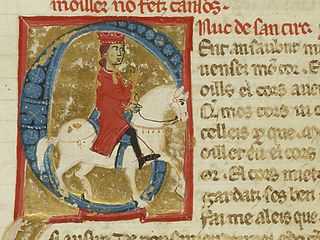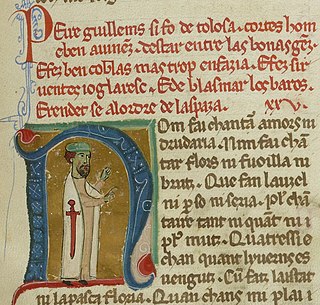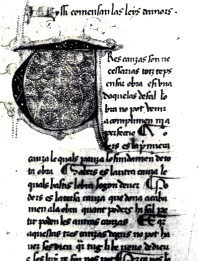
Peire Cardenal was a troubadour known for his satirical sirventes and his dislike of the clergy. Ninety-six pieces of his remain, a number rarely matched by other poets of the age.

Peire Vidal was an Old Occitan troubadour. Forty-five of his songs are extant. The twelve that still have melodies bear testament to the deserved nature of his musical reputation.
The sirventes or serventes, sometimes translated as "service song", was a genre of Old Occitan lyric poetry practiced by the troubadours.
Pierre Bec was a French Occitan-language poet and linguist. Born in Paris, he spent his childhood in Comminges, where he learnt Occitan. He was deported to Germany between 1943 and 1945. After returning, he studied in Paris, where he graduated in 1959. He was one of the founders of the IEO or Institut d'Estudis Occitans as well as its president from 1962 to 1980.

Uc de Saint Circ or Hugues (Hugh) de Saint Circq was a troubadour from Quercy. Uc is perhaps most significant to modern historians as the probable author of several vidas and razos of other troubadours, though only one of Bernart de Ventadorn exists under his name. Forty-four of his songs, including fifteen cansos and only three canso melodies, have survived, along with a didactic manual entitled Ensenhamen d'onor. According to William E. Burgwinkle, as "poet, biographer, literary historian, and mythographer, Uc must be accorded his rightful place as the 'inventor' (trobador) of 'troubadour poetry' and the idealogical trappings with which it came to be associated."

Peire Guillemde Tolosa was a 13th-century troubadour from Toulouse. Only one sirventes he wrote, a tenso with the contemporary Italian poet Sordello, survives.

Rambertino di Guido Buvalelli, a Bolognese judge, statesman, diplomat, and poet, was the earliest of the podestà-troubadours of thirteenth-century Lombardy. He served at one time or other as podestà of Brescia, Milan, Parma, Mantua, Genoa, and Verona. Ten of his Occitan poems survive, but none with an accompanying melody. He is usually regarded as the first native Italian troubadour, though Cossezen and Peire de la Caravana may precede him. His reputation has secured a street named in his honour in his birthplace: the Via Buvalelli Rambertino in Bologna.

Peire Guilhem de Luserna was a Piedmontese troubadour.

Peire Bremon Ricas Novas was a Provençal troubadour who left behind twenty works: thirteen cansos, six sirventes, and one tenso. His treatment of courtly love was somewhat original.
Peirede la Mula was an Italian troubadour. Of his writings a pair of couplets and one sirventes are all that survive. According to his vida, he was a joglars and trobaire (troubadour) who stayed for a long time in Montferrat, Cortemilia, and the Piedmont at the court of Ottone del Carretto. This places Peire's activity before 1209, when Ottone lost Cortemilia.
Peire Lunel de Montech, also known as Cavalier Lunel or Peire de Lunel, was a lawyer, politician and author of Toulouse. His name indicates he was a knight from Montech.
Bertran de Gourdon or Bertram de Gordon was the lord of Gourdon, a knight and troubadour.
Bernart de la Barta, also spelled Bernarnz Delabarta or Benart de la Barda, was a troubadour from La Barthe, the location of which is unknown. He wrote two tensos, a fragment (cobla) of a satire, and a sirventes, "Foilla ni flors, ni chatuz temps ni fredura", an attack on terms of the Treaty of Meaux (1229), by which Raymond VII of Toulouse surrendered to Louis IX of France, thus ending the Albigensian Crusade.

The Consistori del Gay Saber was a poetic academy founded at Toulouse in 1323 to revive and perpetuate the lyric poetry of the troubadours.
Arnaut Plagues or Plages was a troubadour probably from Provence.
There were three troubadours named Isarn or Izarn, and who are difficult to distinguish completely today. The first has no surname and composed two partimens with Rofian around 1240. He has been confounded with the inquisitor Isarn.

Joseph Anglade (1868–1930) was a French philologist. He specialized in Romance languages, particularly Occitan, and studied the lyrics of the troubadours. He was instrumental in formalizing the term Occitan for the language of Provence.
Duran Sartor de Paernas or Duran Sartre de Carpentras was a Provençal troubadour from Pernes near Carpentras. The nickname sartor means "tailor". Two sirventes have been attributed to him, both reflect opposition to the royal crusade in Occitania: "Vil sirventes leugier e venassal" was written towards 1210, certainly before 1220, and "En talent ai qu'un sirventes encoc," which was written in 1242, during the Saintonge War. Although Duran criticises the crusade against alleged heretics, he encourages further efforts at crusading against Muslims.
Amanieu de la Broqueira was a Gascon troubadour. His name suggests he was from Labroquère, near Saint-Bertrand-de-Comminges. He wrote two cansos that have been preserved in the 14th-century troubadour chansonnier E :
Guilhem d'Anduza was a minor troubadour active in the middle of the thirteenth century. He belonged to the family of the lords of Anduze, who were patrons of several other troubadours.









